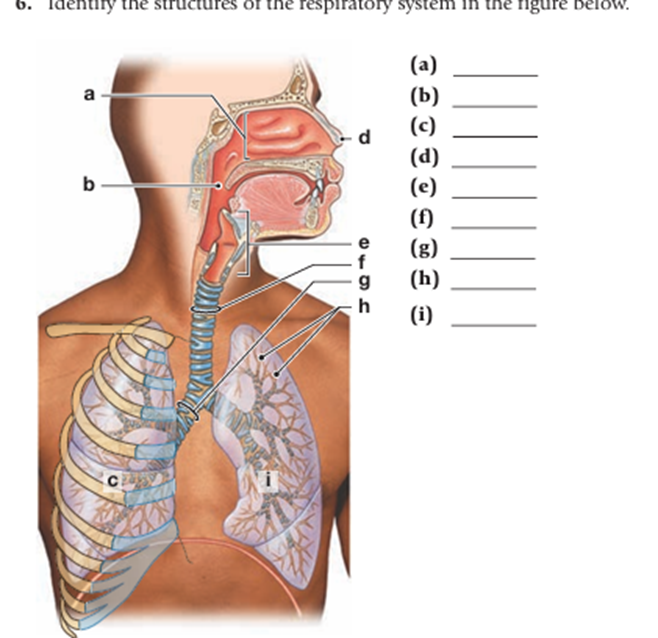Respiratory Anatomy Qns based on book
1/13
There's no tags or description
Looks like no tags are added yet.
Name | Mastery | Learn | Test | Matching | Spaced |
|---|
No study sessions yet.
14 Terms
The blood-air barrier of the alveoli contains
the capillary endothelium
The pharyngeal tonsil is located in the
posterior wall of the nasopharynx
Air moves into the lungs because
the gas pressure in the lungs is less than atmospheric pressure
To keep the air passages open, rings or plates of cartilage reinforce their walls. However, no cartilage is present in the walls of some passageways. Which passageway(s) are these?
the bronchioles
All of the following muscles are accessory respiratory muscles except
diaphragm

Label the diagram
a) nasal cavity
b) pharynx
c) right lung
d) nose
e) larynx
f) trachea
g) bronchus
h) bronchioles
i) left lung
During the winter, Sherwin sleeps in a dorm room that lacks any humidifier for the heated air. In the mornings he notices that his nose is “stuffy,” similar to when he has a cold, but after showering and drink ing some water, the stuffiness disappears until the next morning. What might be the cause of Sherwin’s nasal condition?
Since the air Sherwin is breathing is dry, large amounts of moisture are leaving the mucus in his respiratory tract to humidify inhaled air. Drying makes the mucus viscous and makes it difficult for the cilia to move, so mucus builds up, producing nasal congestion by morning. When Sherwin showers and drinks fluids, body water is replaced, so the mucus loosens up and can be moved along as usual.
Distinguish the structures of the upper respiratory system from those of the lower respiratory system.
Upper respiratory system: nose, nasal cavity, paranasal sinuses, pharynx
Lower Respiratory system: larynx, trachea, bronchi, bronchioles, alveoli
Name the two mucosal regions in the nasal cavity. What is the difference between these two regions?
Larger part of nasal cavity covered by respiratory mucosa which contributes to the quality of inhaled air.
Upper part covered by olfactory mucosa which contains receptors providing the sense of smell
List the cartilages of the larynx. What are the functions of each?
Thyroid cartilage: forms anterior walls of the larynx
Cricoid cartilage: Protects the glottis and entrance to the trachea
Epiglottis: forms a lid over the glottis.
Arytenoid cartilages and corniculate cartilages: formation of sound
Cuneiform cartilages: found in the folds of the larynx
Why is breathing through the nasal cavity more desirable than breathing through the mouth?
Nasal cavity moistens and warms inhaled air. The mouth does not.
Drier air entering through the mouth can irritate the trachea and cause throat soreness.
How does the epiglottis prevent food from entering the respiratory tract?
The epiglottis forms a lid over the entrance of the larynx.
During swallowing, the larynx is elevated and the epiglottis folds back over the glottis preventing food from entering the respiratory tract.
What happens when a fish bone or a fine chicken bone pierces the laryngeal wall?
A fish bone or a fine chicken bone that pierces the laryngeal wall can cause a laryngeal spasm and swelling, restricting the airway.
Contrast diaphragmatic breathing and costal breathing. Which of these two becomes dominant during pregnancy, and why?
During diaphragmatic breathing, air is drawn into the lungs mainly by contraction of the diaphragm.
Air is exhaled passively when the diaphragm relaxes.
In costal breathing, inhalation takes place mainly by contractions of the external intercostal muscles.
Exhalation occurs passively when these muscles relax.
Pregnant women rely more on costal breathing as the enlarging uterus pushes the abdominal organs against the diaphragm, restricting diaphragmatic movements.